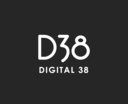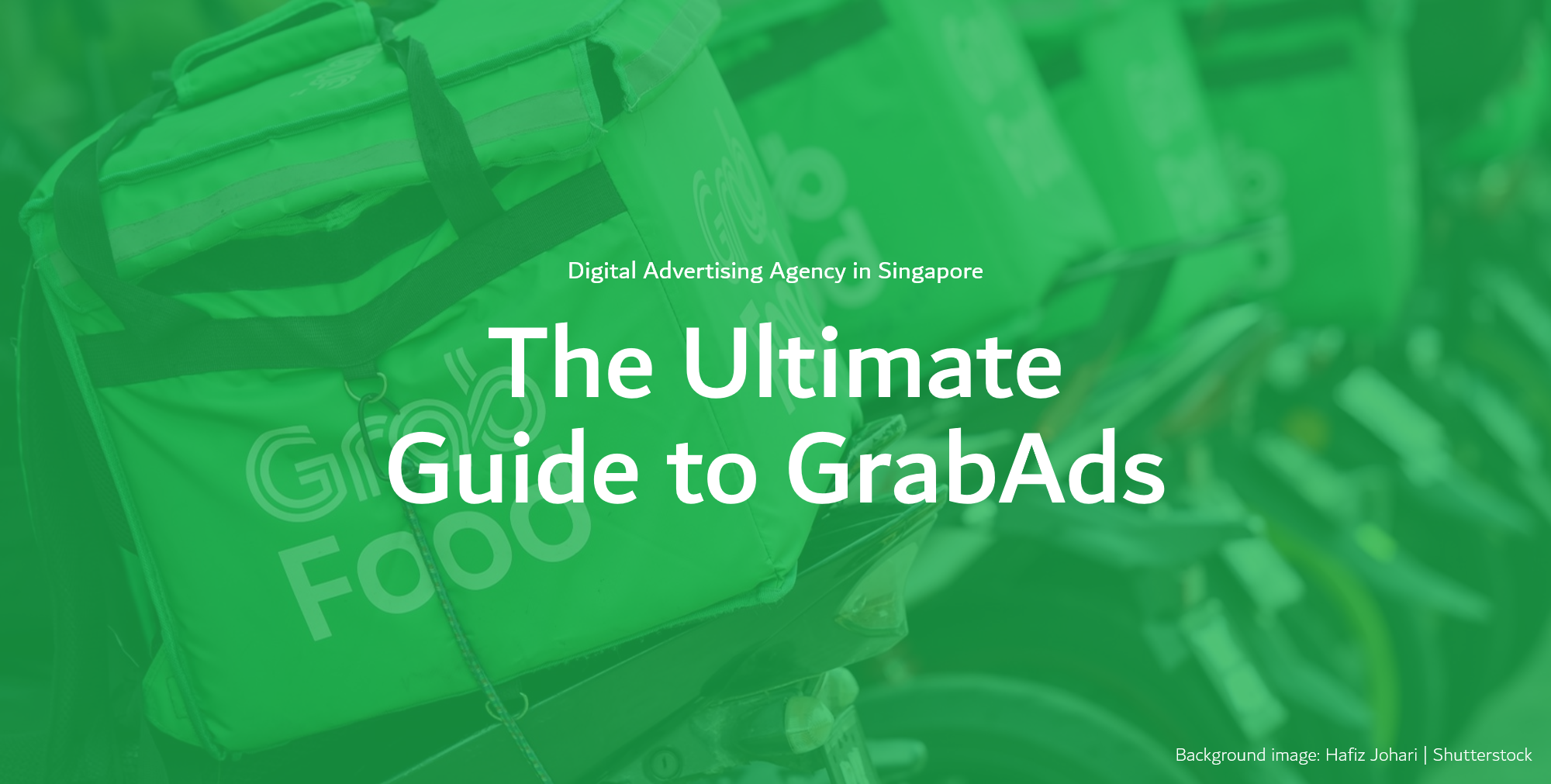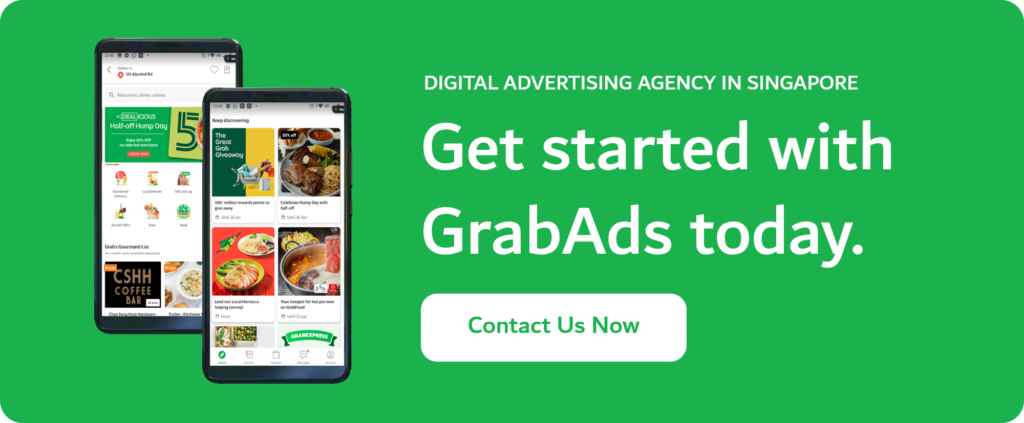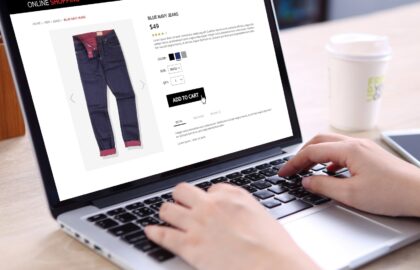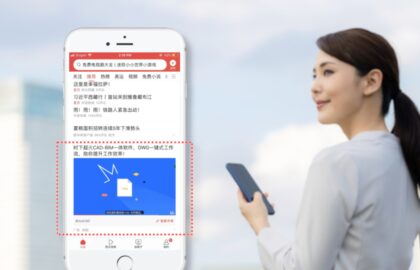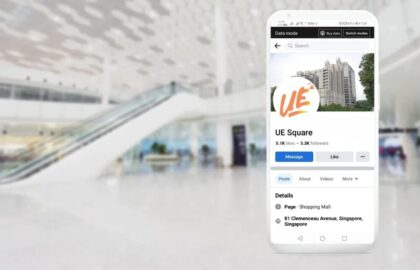- What is Grab and what are the services it offers?
- Understanding and reaching the right audience with GrabAds
- GrabAds advertising opportunities
- Online-to-offline marketing and how it works
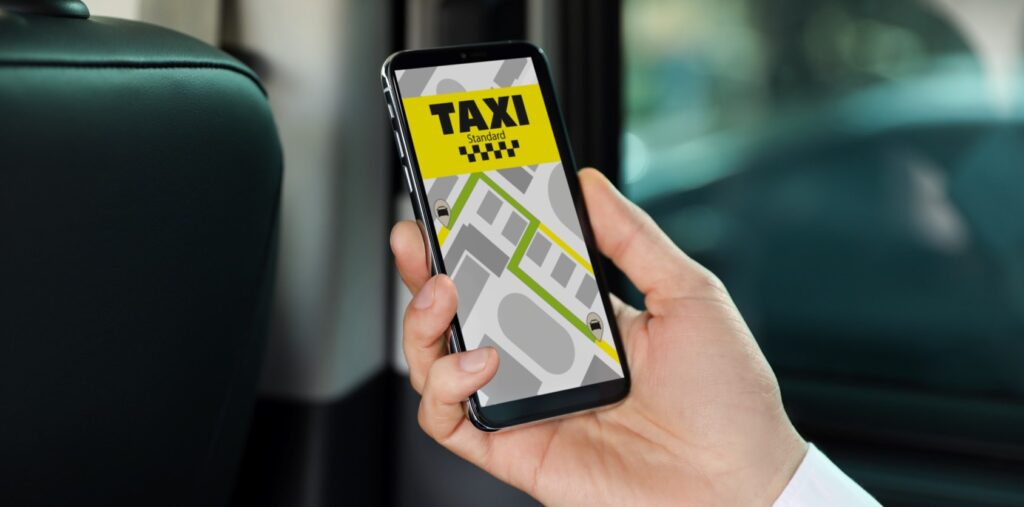
GrabAds has turned into an essential advertising tool for businesses over the years. With Grab leading the ride-hailing industry in Southeast Asia, it certainly has made itself a prized opportunity for every marketer in the region.
From transportation to food delivery, the ride-hailing app has formed a huge part in every Asian’s daily life. Even the introduction of GrabPay as a cashless payment method has made lives more convenient and easier to manage from day to day.
Despite the proliferation of competitors in Southeast Asia, Grab remained as the top ride-hailing app in the region. Owing to its products like GrabFood and GrabMart, it led to Grab becoming the region’s first “decacorn” – a startup with a valuation of over US$10 billion in 2019.
As a result, more and more marketers view Grab as a big opportunity to build awareness and generate sales. And in special times like this, experienced advertisers turn to GrabAds when and where consumers need it the most.
Here, we’ll widely talk about how you can maximise the potential of GrabAds for your business. From understanding your audience to ad types, this guide will walk you through the fundamentals of Grab advertising.
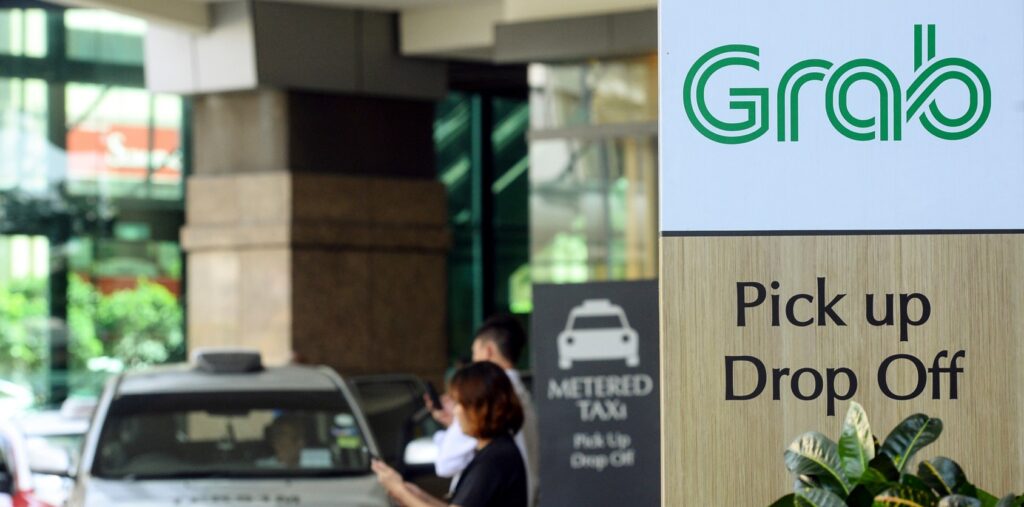
What is Grab?
Grab was launched in 2011 by Anthony Tan and Tan Hooi Ling. Presently headquartered in Singapore, it’s presence span 339 cities and 8 countries in the Southeast and East Asian regions. This includes Singapore, Malaysia, Myanmar, Philippines, Thailand, Vietnam, Japan, Cambodia, and Indonesia.
Grab first operated as MyTeksi or GrabTaxi – a tax-booking mobile app for SEA. Over the years, the company expanded to neighbouring regional countries until it formed the biggest e-taxi fleet in the region.
Eventually, in 2016, the company rebranded to “Grab” to encompass all products, such as GrabCar, GrabHitch, and GrabExpress.
Furthermore, Grab also acquired Uber’s Southeast Asia assets and operations in 2018. Along with the acquisition came UberEats, which was shortly launched as GrabFood – an in-app food delivery service.
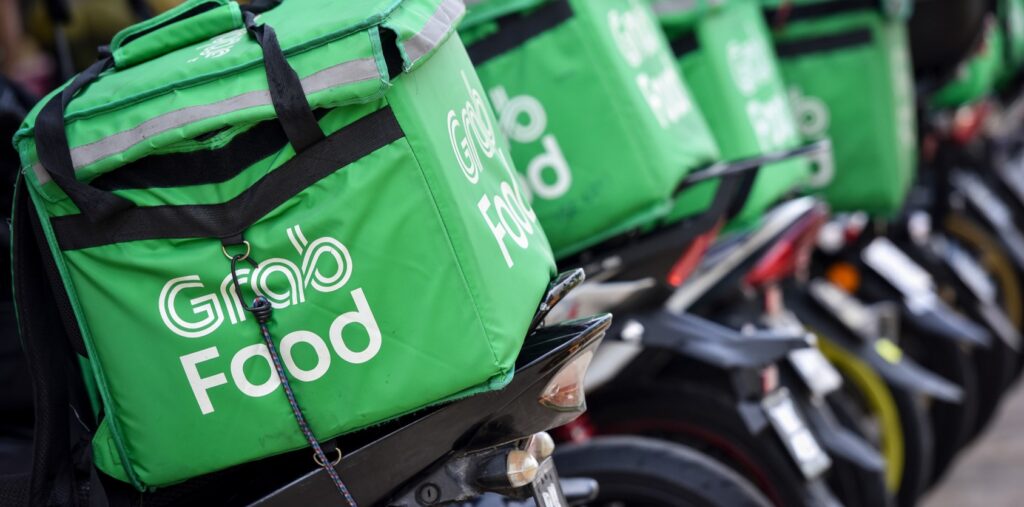
Grab Transport, Food Delivery and Payment Solutions for SEA
Grab offers plenty of consumer services for mobility, fintech, and lifestyle. While most of the ad formats appear on the home feed, it’s also important to know Grab’s availability in your target market. This way, you have a deeper understanding of when, why, how and where your customers use the app for better audience targeting.
So, to ease your research, we’ve collated the full range of consumer services across the markets below for quick reference.
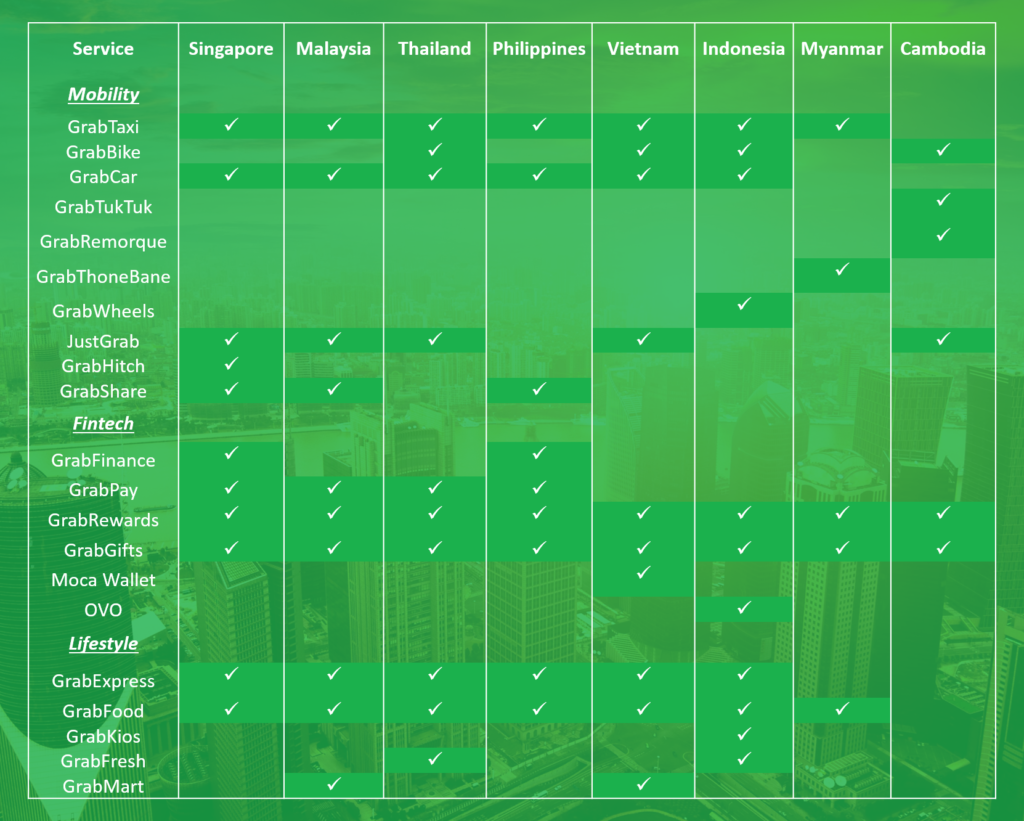
Sources: Grab regional websites (Singapore, Malaysia, Thailand, Philippines, Vietnam, Indonesia, Myanmar, Cambodia)
From the illustration above, we can say that Grab’s services are prevailing in all markets in terms of mobility, fintech and lifestyle ranges.
Among the ride services, GrabTaxi is the widely available service in all but one market – Cambodia. Followed by GrabCar, which only excludes Myanmar and Cambodia. Coming next is JustGrab, which is only inexistent in the Philippines, Indonesia, and Myanmar.
Meanwhile, under the fintech range, GrabRewards and GrabGifts are largely present in all countries. GrabPay, on the other hand, only operates in four markets. For Vietnam and Indonesia, the in-app payment feature is powered by technologies of local providers, such as Moca and OVO respectively.
Lastly, GrabFood is also existent in all countries, except Cambodia. Not to mention GrabExpress, which is offered in all markets, excluding Myanmar and Cambodia.
Now that you know which Grab services are present in your target market, let’s see how Grab reaches various audiences.
Understanding and Reaching the Right Audience with GrabAds
Back in 2018, Grab announced the launch of its advertising business unit – GrabAds – as reported by Singapore Business Review. Since then, its advertising services continued to expand and improve over time with mobile billboards, in-car engagement, and in-app engagement for brands.
Furthermore, GrabAds aims to employ its big data capabilities, local market insights and O2O presence to better target the right audience for your business. With its large user base and offline distribution channels, it’s easier for advertisers to see through the audience and devise the most fitting campaigns.
Through its unique and clearly-defined audience, you can also segment your audience to match your marketing goals.
Interesting Facts about Grab
To have a better grasp of Grab’s massive user base, let’s take a look at some interesting 2019 statistics about the ride-hailing platform:
- 166 million total mobile app downloads
- 9+ million or 1 in 70 people in SEA are micro-entrepreneurs across the Grab network
- 400% growth in cashless transaction on Grab
- Singapore (77%) has the highest cashless transactions on Grab
- 1 in 10 commuters use Grab’s first and last-mile rides
- Commercial buildings are the top first-mile pick-up point
- Residential buildings are the top last-mile drop-off point
- 130% growth in shared rides
- GrabRewards is SEA’s largest loyalty programme with over 440 merchants spanning the region
Sources: Grab Corporate Profile 2019, Grab Social Impact Report 2018-2019
Top Pick-up Points in Southeast Asian Cities
Furthermore, these are the top 3 pick-up points in the major SEA countries.
- Singapore: Changi Airport, Woodlands Checkpoint, Marina Bay Sands
- Malaysia: City Square, JB Sentral, KSL City Mall
- Thailand: Don Mueang Airport, Suvarnabhumi Airport, The Berkeley Hotel Pratunam
- Philippines: Ninoy Aquino International Airport, Makati Shangri-La, Holiday Inn Makati
- Vietnam: Tan Son Nhat International Airport (Ho Chi Mind), Noi Bai Airport (Hanoi), Ben Thanh Street Food Market (Ho Chi Minh)
- Indonesia: Ngurah Rai International Airport (Bali), Soekarno-Hatta International Airport (Jakarta), Grand Indonesia Mall (Jakarta)
- Myanmar: Myanmar Plaza, Junction City, Yangon International Airport

Based on the data above, you can find that majority of the Grab ride users are either from international airports, luxury hotels or shopping malls. Even tourist destinations like the Ben Thanh Street Food Market in Ho Chi Minh topped the pick-up point list.
With all this information, you can now have an upgraded knowledge on the kind of audience you can target with GrabAds. Likewise, leverage GrabAds’ audience segmentation capability, so your ads show to the right people at the right place and the right moment.
Moving on, let’s now define the best GrabAds solution for your business.
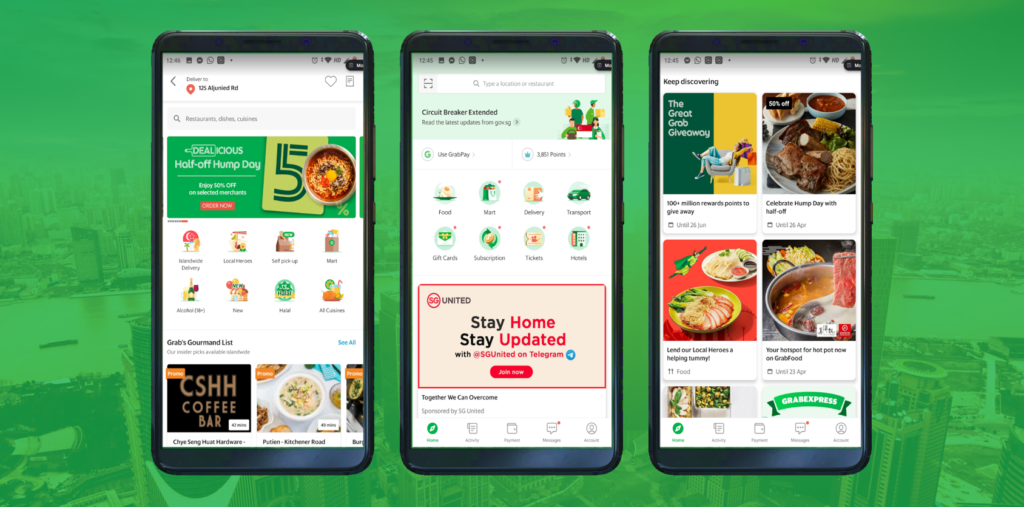
GrabAds Digital Advertising Opportunities
Since this guide aims to help you with digital advertising on Grab, we will focus more on GrabAds’ in-app opportunities. However, let’s begin with a brief overview of all of its advertising services.
GrabAds offers integrated advertising solutions that target people always on the move. Through GrabAds, you can connect with millions of people throughout the region, both online and offline. Along with the right strategy, you can achieve incredible results with the following GrabAds solutions:
- Mobile billboards – car and bus wraps
- In-car engagement – in-car branding, sampling, and digital display
- In-app opportunities – targeted GrabGifts, sponsored comms, GrabDaily Widget
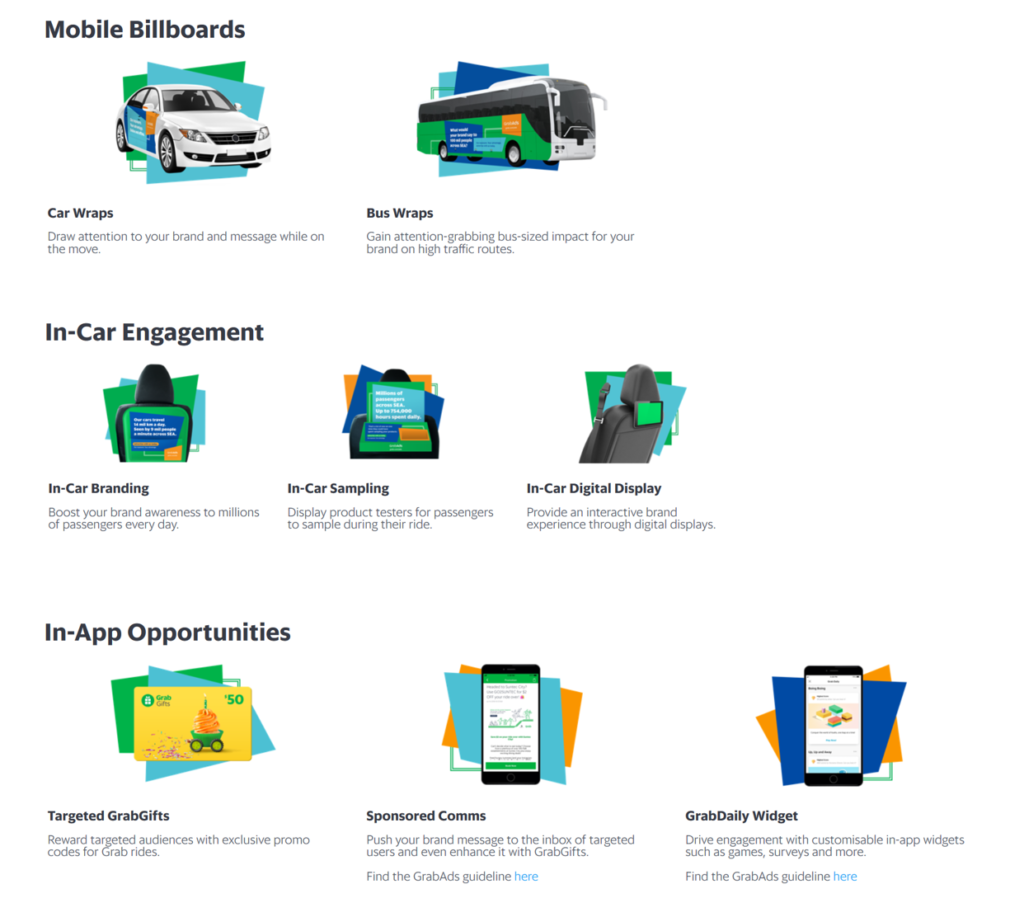
What makes GrabAds a considerable success factor is it follows the audience through the buyer’s journey from awareness to conversion – both online and offline.
With in-app ads, you can easily guide your target audience from seeing your brand to buying it in-store.
How GrabAds Work
As you explore this opportunity, it’s important to know when and where to target your consumers. In GrabAds, you can effortlessly go after your desired audience across the buyer’s journey.
There are three stages in a consumer’s journey: awareness, consideration, and conversion or decision.
According to HubSpot, awareness is when the buyer realises they have a problem. Next is the consideration stage, when the buyer defines the problem and looks for options to solve it. Lastly, the decision stage is when the buyer chooses a solution. And that’s when the conversion occurs.
Based on the process above, GrabAds enables a seamless advertising service for all, targeting consumers from start to end.
Now, let’s chart the buyer’s journey with GrabAds.
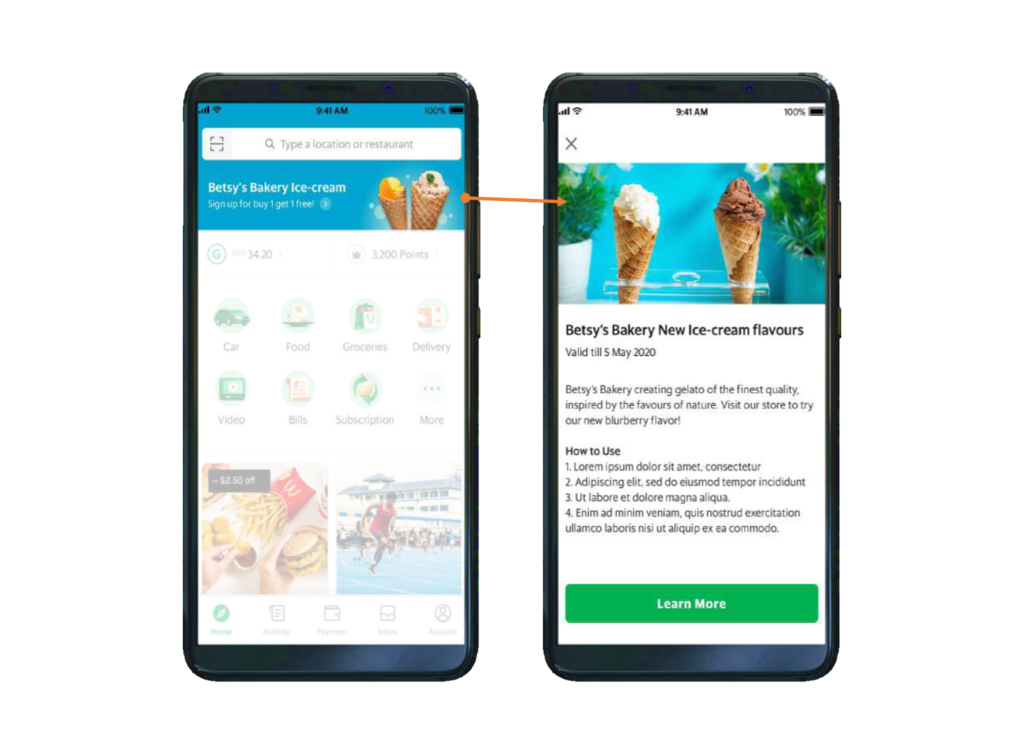
Integrated Masthead
This ad is placed in the most noticeable position, which is the top of the page upon app launch. It includes a landing page that leads users to a Grab service or a details page.
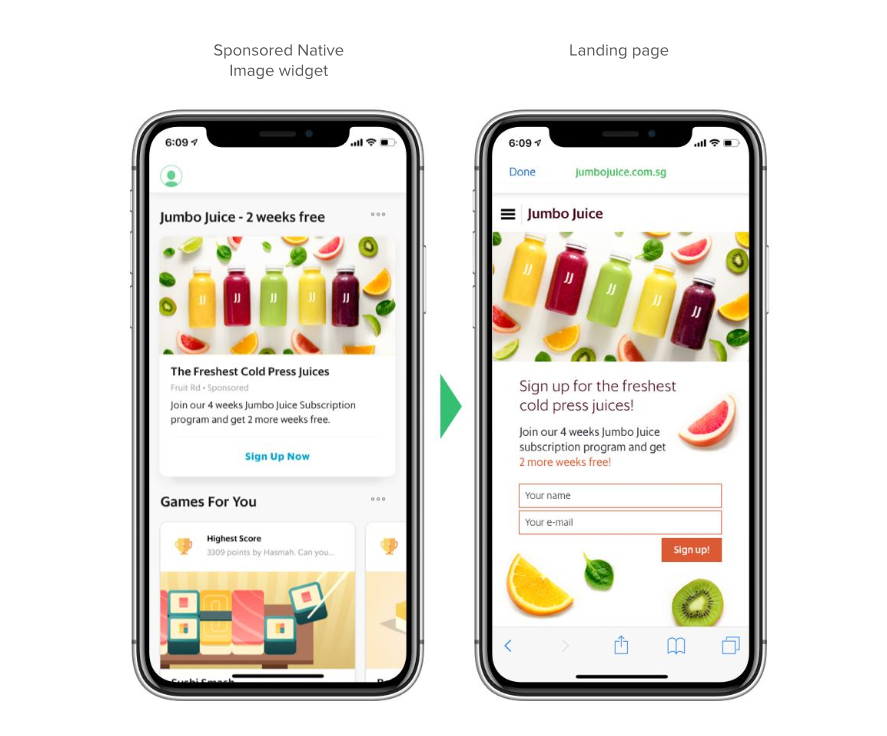
Sponsored Native Image
This ad format is a standalone native image ad that shows in the home screen feed of the app. It includes a landing page that directs users to a Grab service or an in-app web browser. It also consists of customisable components like widget name, image, headline, body copy, and call-to-action (CTA).
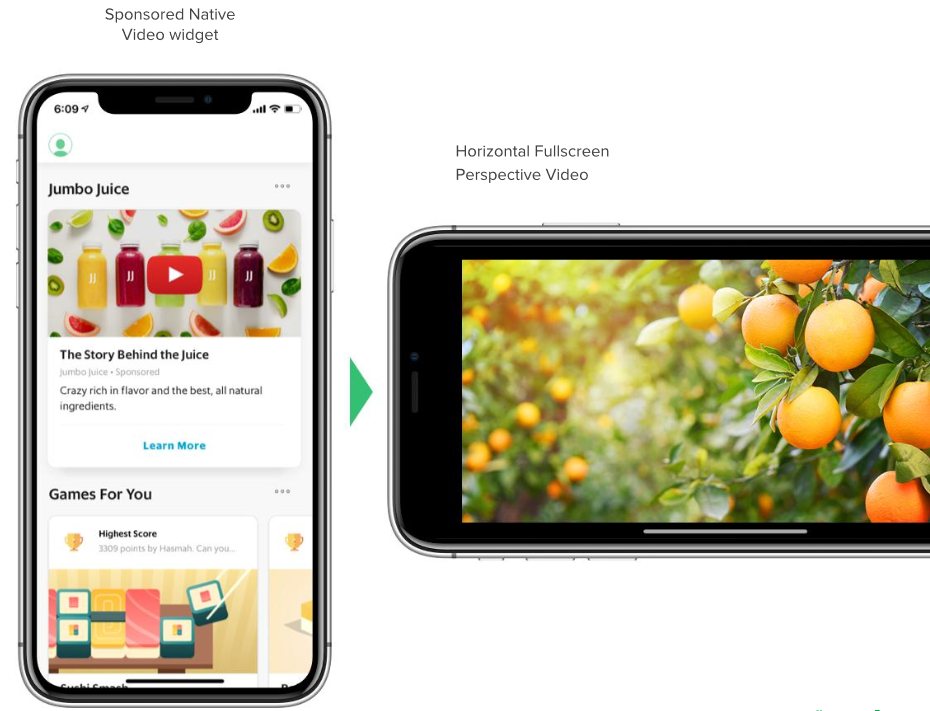
Sponsored Native Video
Similar to the sponsored native image ad, this is also a standalone native ad that shows in the home screen feed. It includes 2 CTAs – one for playing the video, and the other for opening the landing page. Moreover, the ad format contains a widget name, video, video title, body copy, and CTA.
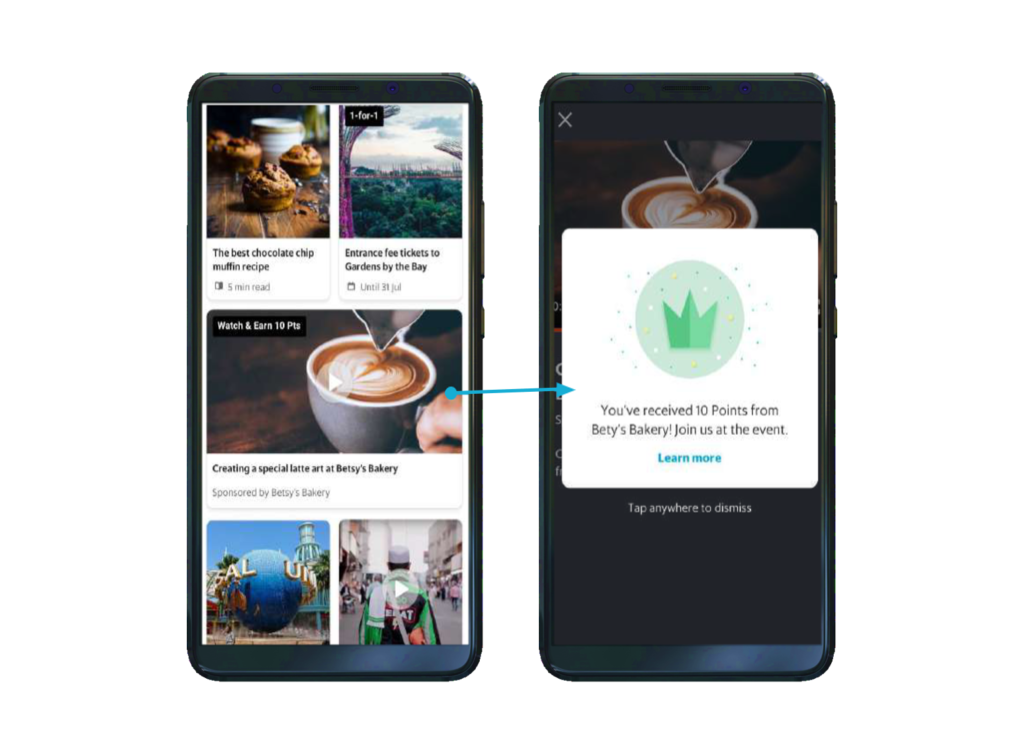
Rewarded Video
This ad format appears in the app’s home feed as a standalone widget. Upon completing the action required, the app user receives Grab points confirmed by a popup notification.
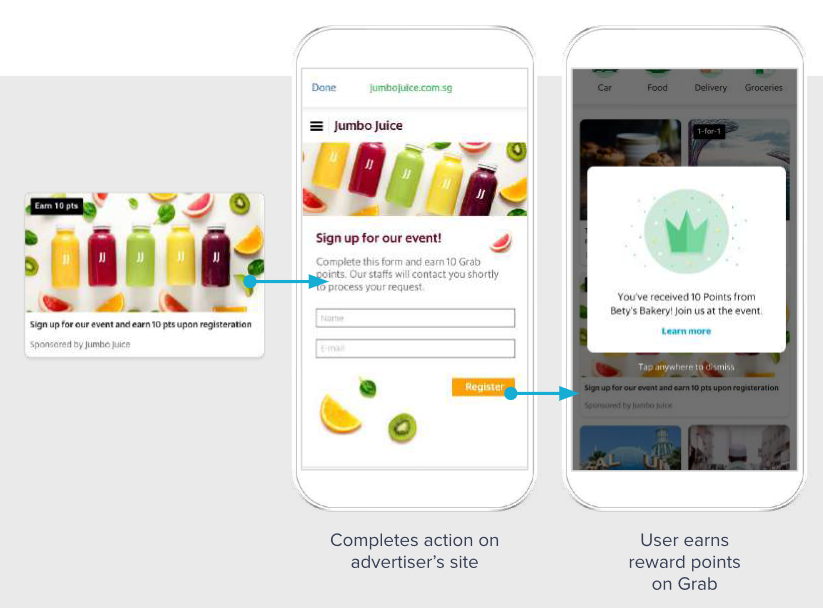
Rewarded Conversion Ads
If you are looking to generate leads or urge a consumer to purchase at the moment, this is the best solution for you. This ad type appears on the app’s native feed, similar to the previous rewarded video ads. When the user completes the required action on the advertiser’s website, the user will receive points verified by a popup notification.
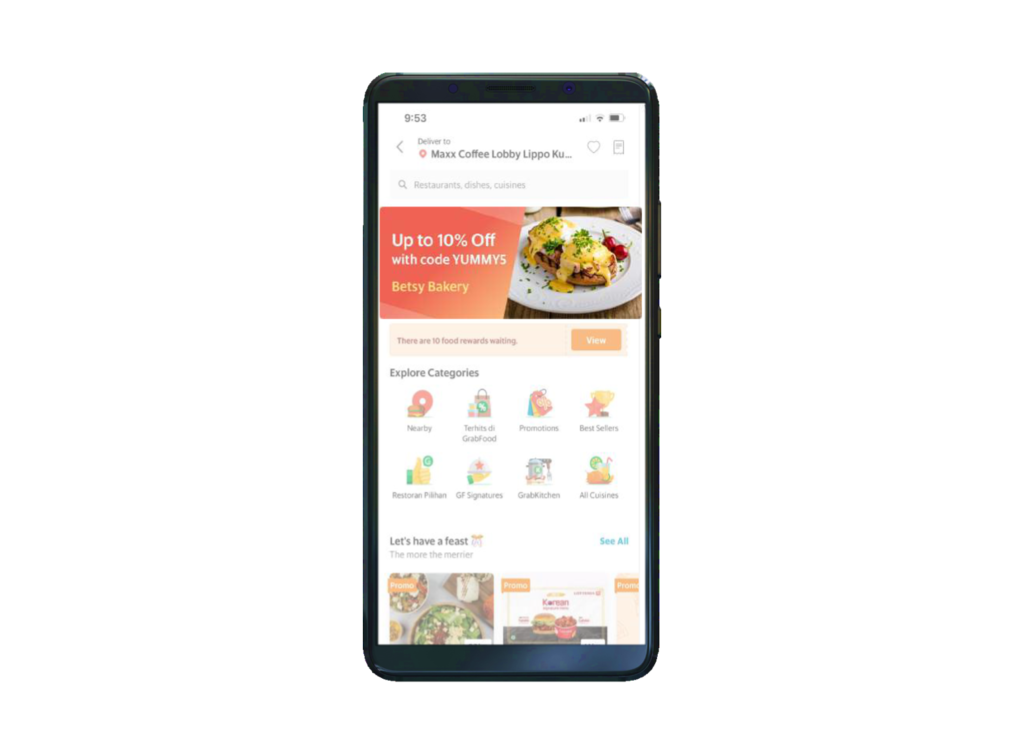
GrabFood Power Banner Ad
This ad type aims at users using the GrabFood service. It immediately shows upon opening GrabFood and only appears to users within your delivery radius. Moreover, your ads can be targeted by audience or cuisine affinities.
And finally, for the last stage in the consumer journey, GrabAds also devised an O2O last-mile advertising strategy to drive offline sales from online. In the next section, you’ll learn what O2O is and how it works.
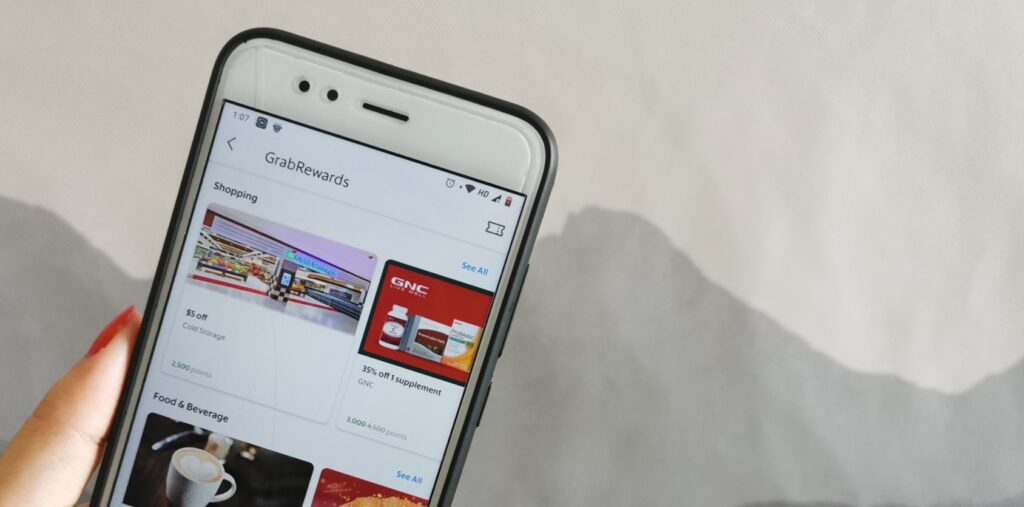
Online-to-Offline Marketing with GrabAds
Based on many successful Grab advertising campaigns, the ride-hailing platform is doing a good job of implementing online-to-offline marketing.
But what is online-to-offline marketing? According to Wikipedia, it is defined as:
…a phrase that is used in digital marketing to describe systems enticing consumers within a digital environment to make purchases of goods or services from physical businesses.
Commonly abbreviated as O2O, it is a two-way flow between the online and offline world, which is typically used for retail and e-commerce.
In the case of Grab, the platform is a suitable mobile advertising tool to implement O2O marketing. And with their substantial rewards programme, they saw an opportunity to leverage O2O marketing’s potential success in propelling offline sales.
Let’s dig further into how Grab directs audiences from online awareness and consideration to offline purchases.
How GrabAds O2O Last Mile Strategy Works
It is important to have an ad that highlights your business’ unique selling point. This way, people will become more aware of your product or service, leading to exploring your brand ultimately.
Once the consumer is convinced to find out more about the ad, they view and save the reward. This increases the chances of making an actual purchase offline.
The last stage is when the consumer redeems the reward in the physical store.
How does Grab enable online-to-offline purchase? The rewards can only be redeemed in-app and used when they visit the store or restaurant. In fact, a PIN code will be sent to the user when it is being redeemed in-store.
Most importantly, offline sales related to GrabRewards can be easily tracked, thus, enabling you to measure your ad success.
To recap, here’s the full O2O journey:
- The consumer sees the ad on the Grab platform
- The consumer considers and saves the reward
- Consumer redeems the reward in-store
- The offline sale will be tracked to measure ad success
Key Takeaway
Whether you’re looking to boost your brand awareness or generate leads or offline sales, GrabAds is there to help you achieve your goals. Apart from out-of-home advertising solutions like mobile billboards and in-car advertisements, it also offers valuable in-app opportunities. This includes integrated masthead, sponsored native image or video ads, rewarded video and conversion ads, and GrabFood Power Banner ads.
Furthermore, GrabAds employed the online-to-offline strategy to help businesses drive offline sales. Besides going after the users throughout the buyer’s journey, it also allows tracking of offline sales related to in-store reward redemptions.
By learning how GrabAds can help you leverage their platform and its many advantages, you are now more equipped to pursue advertising on Grab. And with Grab’s solid presence in the Southeast Asian region, you have higher chances of succeeding in your chosen market.
About the Author
IH Digital is a digital marketing agency headquartered in Singapore. Spanning Southeast Asia and Greater China, we have offices in Malaysia, Philippines, Thailand, Vietnam, China, Hong Kong, and Taiwan.
We offer digital advertising services to regional businesses, including GrabAds. Recently, we have extended our partnership with Grab allowing us to support Grab advertising for you.
If you are interested to learn more, click the button below to speak to our marketing experts.
